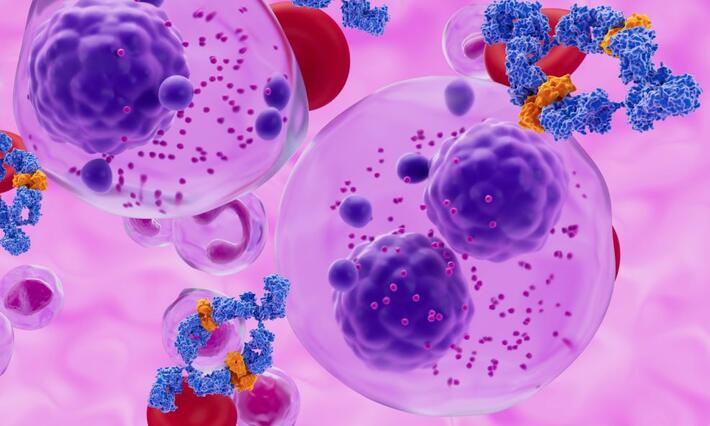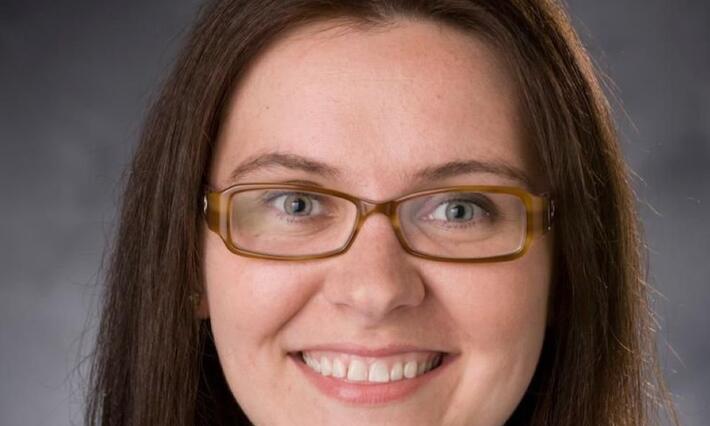
Onco-Fertility Services Make Patients' Family-Dreams Come True
Published
Written By

Frances Rogers
Senior Communications Specialist, Duke University Hospital
Related News

New Research Targets Iron Dependency in Multiple Myeloma Cells
Multiple myeloma remains one of the most challenging hematologic malignancies to treat. Despite advances in therapy, many patients eventually relapse or develop resistance to standard treatments.A team led by Mikhail Nikiforov, PhD, professor in the Duke University School of Medicine Department of Pathology and Biomedical Engineering, and Duke Cancer Institute member, is uncovering a promising new approach that could reshape the therapeutic landscape.Multiple myeloma is characterized by uncontrolled proliferation of plasma cells, which produce large amounts of dysfunctional antibodies. These abnormal proteins can damage organs such as the kidneys and weaken bones, leading to pain and fractures.The disease environment in the bone marrow is rich in iron, a nutrient essential for cell growth and DNA synthesis. Cancer cells exploit this iron abundance to fuel their rapid proliferation.However, excess iron can also trigger a unique form of cell death called ferroptosis, driven by oxidative damage to cell membranes.“Ferroptosis is a programmed death caused by iron-dependent lipid peroxidation, and it’s particularly relevant in iron-loaded environments like the bone marrow,” Nikiforov said.Nikiforov’s team focused on why some myeloma cells resist ferroptosis. Using genetic screening, they identified a kinase called STK17B as a key player. High levels of STK17B not only suppress ferroptosis but also correlate with poor patient survival and resistance to bortezomib, a cornerstone drug in myeloma therapy.“This kinase appears to help cancer cells maintain iron balance and avoid ferroptotic death,” Nikiforov said. “When we inhibit STK17B, iron overload tips the scale, and the cells die.”The team collaborated with Timothy Willson, PhD, Harold Kohn distinguished professor in open science drug discovery at the University of North Carolina Eshelman School of Pharmacy, who had previously developed an STK17B inhibitor. Using an improved formulation, they tested the compound in two myeloma models and observed significant efficacy.The findings were strong enough to warrant a provisional patent and open the door for future drug development. Currently, no FDA-approved therapies specifically induce ferroptosis.“Our work suggests a new therapeutic angle—targeting iron addiction in cancer cells,” Nikiforov said. “It could complement existing treatments and potentially apply to other iron-rich tumors.”Future research will explore combination strategies with standard therapies and immune-based approaches, as well as whether ferroptosis-targeting drugs could benefit other cancer treatments. The team is also investigating what regulates STK17B activity, aiming to uncover additional intervention points.“We’re excited about the possibilities,” Nikiforov said. “It’s early, but the data are compelling.”

Related News

New Research Targets Iron Dependency in Multiple Myeloma Cells
Multiple myeloma remains one of the most challenging hematologic malignancies to treat. Despite advances in therapy, many patients eventually relapse or develop resistance to standard treatments.A team led by Mikhail Nikiforov, PhD, professor in the Duke University School of Medicine Department of Pathology and Biomedical Engineering, and Duke Cancer Institute member, is uncovering a promising new approach that could reshape the therapeutic landscape.Multiple myeloma is characterized by uncontrolled proliferation of plasma cells, which produce large amounts of dysfunctional antibodies. These abnormal proteins can damage organs such as the kidneys and weaken bones, leading to pain and fractures.The disease environment in the bone marrow is rich in iron, a nutrient essential for cell growth and DNA synthesis. Cancer cells exploit this iron abundance to fuel their rapid proliferation.However, excess iron can also trigger a unique form of cell death called ferroptosis, driven by oxidative damage to cell membranes.“Ferroptosis is a programmed death caused by iron-dependent lipid peroxidation, and it’s particularly relevant in iron-loaded environments like the bone marrow,” Nikiforov said.Nikiforov’s team focused on why some myeloma cells resist ferroptosis. Using genetic screening, they identified a kinase called STK17B as a key player. High levels of STK17B not only suppress ferroptosis but also correlate with poor patient survival and resistance to bortezomib, a cornerstone drug in myeloma therapy.“This kinase appears to help cancer cells maintain iron balance and avoid ferroptotic death,” Nikiforov said. “When we inhibit STK17B, iron overload tips the scale, and the cells die.”The team collaborated with Timothy Willson, PhD, Harold Kohn distinguished professor in open science drug discovery at the University of North Carolina Eshelman School of Pharmacy, who had previously developed an STK17B inhibitor. Using an improved formulation, they tested the compound in two myeloma models and observed significant efficacy.The findings were strong enough to warrant a provisional patent and open the door for future drug development. Currently, no FDA-approved therapies specifically induce ferroptosis.“Our work suggests a new therapeutic angle—targeting iron addiction in cancer cells,” Nikiforov said. “It could complement existing treatments and potentially apply to other iron-rich tumors.”Future research will explore combination strategies with standard therapies and immune-based approaches, as well as whether ferroptosis-targeting drugs could benefit other cancer treatments. The team is also investigating what regulates STK17B activity, aiming to uncover additional intervention points.“We’re excited about the possibilities,” Nikiforov said. “It’s early, but the data are compelling.”

